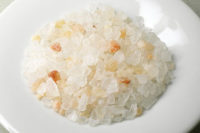Sodium-reduction efforts remain on the food industry's radar, but those effortsare proving more complex and challenging than simply finding a new version of salt.
Consider one projection from Michael Jacobson, executive director of Center for Science in the Public Interest. Asked what consumers could expect in their kitchens in 2050, Jacobson predicted high-sodium foods would no longer be a problem, thanks to a variety of salt substitutes developed and added to soups, baked goods and condiments. However, present-day reality is significantly far away from his vision.
In fact, one recent study found that such salt substitutes, at least as presently envisioned, are not necessarily the answer to skyrocketing sodium consumption levels. The study published in Food Research International evaluated seven varieties of sea salt versus a Kosher control; it found that the salts contained either "the same or less sodium than the Kosher salt...This investigation revealed that only small differences in sodium content are seen among samples and, when controlled for sodium content, resulted in marginal differences in salt taste intensity."
Researchers from the University of Guelph's Department of Food Science further elaborated, "This indicates that the use of any of the sea salts studied is not likely a viable sodium-reduction strategy."
Meanwhile, health advocates advise consumers to lower their sodium consumption and consider, too, the 2010 Dietary Guidelines caution that blood pressure increases with increased sodium intake. Yet many Americans remain unaware of this fact or unwilling or unable to omit it from their diets, as 90% of the population is consuming more than the Guidelines recommend. In fact, the American Heart Association, the National Institutes of Health, the Centers for Disease Control and Prevention (CDC), and the National Heart Lung and Blood Institute have noted that Americans would benefit from lowering the amount of sodium in their diets.
Sodium levels should exceed no more than 1,500mg daily for more than half the population, including African-Americans, people over the age of 51 and individuals with high blood pressure. Other consumers are advised to limit their sodium consumption to no more than 2,300mg.
Nevertheless, statistics show American consumption patterns nowhere near that target; on average, Americans consume 3,400mg of sodium every day, and the problem is by no means confined to adults. From 2003-08, the CDC performed a national health survey involving 6,200 U.S. children between the ages of 8-18. The young people logged their food intake, and researchers calculated their salt consumption. The survey found the children eat almost 1,000mg too much salt per day and, furthermore, that 15% of those studied had either high blood pressure or slightly elevated blood pressure called pre-hypertension.
For that matter, high sodium consumption levels are far from a U.S. phenomenon. Sydney University's George Institute for Global Health found the sodium content of more than 28,000 processed foods in Australia has risen an average 9% during the past four years, contrary to federal government and food industry programs to reduce it. The largest culprits were oils, which saw a 16% jump in sodium, followed by sauces and spreads (13%) and cereals (8%). Several foods did actually manage to reduce their sodium levels over that time: dairy products shed 11% of their sodium levels, and bread and bakery items had 8% less.
While many are quick to blame high sodium levels on Western diets, the problem appears to be prevalent worldwide. The Thai News Agency recently reported a government survey found Thais consume about twice the maximum amount of sodium required every day. The country's Deputy Permanent Secretary for Public Health attributed this fact to the country's 21.4% of the population with high blood pressure, 17.5% with kidney problems, 1.4% with constricted heart arteries, and 1.1% with cerebrovascular disease. The demand and advice to the population was identical to that of the CDC's to Americans: lower sodium consumption to 2,400mg per day.
Realizing that school foodservice programs could be both part of the problem but also part of the solution, several vendors and the USDA, itself, have moved to gradually reduce the sodium and fat content in school lunches. Americans of all ages are so accustomed to the taste of sodium that, for lack of a better description, they will have to be slowly weaned off of it.
Food manufacturers have implemented plans to reduce the sodium levels in their foods. Kraft Foods Inc. is in the midst of a three-year initiative to reduce sodium by an average of 10% across its North American portfolio by the end of 2012. The company claims it has eliminated the equivalent of 14 million pounds of salt from North American diets annually, reducing sodium content in more than 1,000 SKUs across 24 product categories.
"Sodium plays several important roles in food, including enhancing taste and texture, as well as helping keep products fresh," explains Russ Moroz, Kraft's vice president of research, development and quality. "But our scientists and product developers also know that more than half of North Americans are interested in lowering their sodium intake. So, we worked hard to make meaningful reductions in sodium, without sacrificing the taste, quality or safety..."
Cereal Partners Worldwide (CPW), the 50/50 joint venture between Nestle and General Mills, also is reducing sodium content as part of an even larger initiative. It has committed to reducesugar content of 20 Nestle breakfast cereal brands sold outside the U.S. to 9g or less per serving by the end of 2015; make whole grains the main ingredient in all of the new recipes; increase calcium per serving to at least 15% of the RDA; and reduce the sodium content to 135mg or less per serving.






